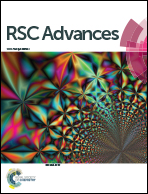pH-related features and photostability of 4-thiothymidine in aqueous solution: an investigation by UV-visible, NMR and FTIR-ATR spectroscopies and by electrospray ionization mass spectrometry
Abstract
The pH-related characteristics of 4-thiothymidine and its stability during prolonged exposure, at room temperature, to a neon lamp emitting in the 400–700 nm wavelength range were investigated by different spectroscopic techniques (UV-Vis, FTIR-ATR, 1H-NMR) and by ElectroSpray Ionization Mass Spectrometry (ESI-MS). The evaluation of the nucleoside photostability was performed as a control, with the perspective of studying its reactivity under the same conditions but in the presence of visible light-absorbing photosensitizers, able to generate reactive oxygen species. The comparison between UV-Vis spectra recorded at different pH values in the 7–12 range suggested the presence of an equilibrium related to the deprotonation of the N3–H group of 4-thiothymidine, with a pKa estimated to be close to 9. Some effects of the deprotonation occurring at alkaline pH were observed also in FTIR-ATR spectra, the main feature being the appearance of a band related to C![[double bond, length as m-dash]](https://www.rsc.org/images/entities/char_e001.gif) N stretching, interpreted with the assumption of a partial double bond character by C2–N3, N3–C4 and C2–O− bonds, as a consequence of negative charge delocalization on the pyrimidine ring. As for photostability, UV-Vis, FTIR-ATR and NMR measurements suggested the generation of thymidine as a by-product but only after a prolonged (48 hours) irradiation time, whereas no significant alteration occurred in a shorter time range (1–2 hours), i.e. the one that will be considered in future studies involving the presence of photosensitizers. The nucleoside stability up to 2 hours of irradiation was confirmed by ESI-MS analyses; furthermore, on the other hand, the latter indicated the presence of three additional by-products, besides thymidine, after 48 hours of irradiation. In particular, an hydroxylated form of 4-thiothymidine and two dimeric species, characterized by S–S and S–O covalent bridges between two 4-thiothymidine and a 4-thiothymidine and a thymidine molecule, respectively, were detected.
N stretching, interpreted with the assumption of a partial double bond character by C2–N3, N3–C4 and C2–O− bonds, as a consequence of negative charge delocalization on the pyrimidine ring. As for photostability, UV-Vis, FTIR-ATR and NMR measurements suggested the generation of thymidine as a by-product but only after a prolonged (48 hours) irradiation time, whereas no significant alteration occurred in a shorter time range (1–2 hours), i.e. the one that will be considered in future studies involving the presence of photosensitizers. The nucleoside stability up to 2 hours of irradiation was confirmed by ESI-MS analyses; furthermore, on the other hand, the latter indicated the presence of three additional by-products, besides thymidine, after 48 hours of irradiation. In particular, an hydroxylated form of 4-thiothymidine and two dimeric species, characterized by S–S and S–O covalent bridges between two 4-thiothymidine and a 4-thiothymidine and a thymidine molecule, respectively, were detected.


 Please wait while we load your content...
Please wait while we load your content...